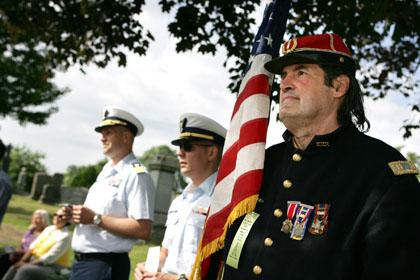By Jeremy Walsh
It seems odd to think a catastrophic maritime disaster involving a boat that embarked from a Manhattan pier full of passengers from the Lower East Side and came to grief in the East River near Astoria would have had the largest impact in Middle Village.
But the memorial — as well as the bodies of many of the 1,020 people who died on the steamship Gen. Slocum June 15, 1904 — sits in All Faiths Cemetery on Metropolitan Avenue. The monument to the 61 unidentified dead from the calamity was unveiled at the cemetery in 1905, and residents of the neighborhood continue to hold a memorial service to keep the memory of the dead fresh.
Military veterans from the neighborhood raised the American flag over the marble monument Saturday morning as some 30 people came to pay their respects to the victims and the survivors, the last of whom died in 2004.
“It’s something that needs to continue,” said Dan Austin Jr., president of the cemetery’s Beautification and Restoration Program, at the memorial service. “There are so many things that happen and get forgotten.”
The Slocum had been chartered by St. Mark’s Lutheran Church in the Little Germany area of Manhattan for a picnic voyage to Locust Point on the north shore of Long Island. With 1,358 parishioners and neighbors, mostly women and children, aboard the paddle wheel steamer departed from an East Third Street pier at about 9 a.m.
But a fire below deck, possibly caused by a carelessly discarded match, grew quickly and was visible to bystanders in Astoria as the ship neared Hell’s Gate.
The crew, which apart from the captain and one other man had never conducted a fire drill, did not alert the captain until it was too late. As they tried to fight the flames, the ship’s firehoses burst under the water pressure.
Lifeboats were glued to the deck and when many passengers jumped overboard, they were dragged beneath the surface by their life preservers, whose buoyant cork filling had turned to absorbent dust over time. Bodies washed up along the Queens waterfront for days afterward. One day soon after the disaster, The New York Times reported there would be 200 funerals at the Middle Village cemetery.
The disaster crushed Manhattan’s Little Germany, and many of the families who could no longer bear to see the old neighborhood moved to Queens.
“The Lutheran and German communities were devastated,” said Serphin Maltese, former state senator for the area. “That’s what created our Middle Village community.”
The Slocum’s destruction also brought about major reforms in the country’s maritime inspection process.
“Every marine inspector knows the Slocum’s story,” said Coast Guard Commander Brian Gilda. “All of the things that we do can be attributed to the loss of the General Slocum.”
Reach reporter Jeremy Walsh by e-mail at jewalsh@cnglocal.com or by phone at 718-229-0300, Ext. 154.
































